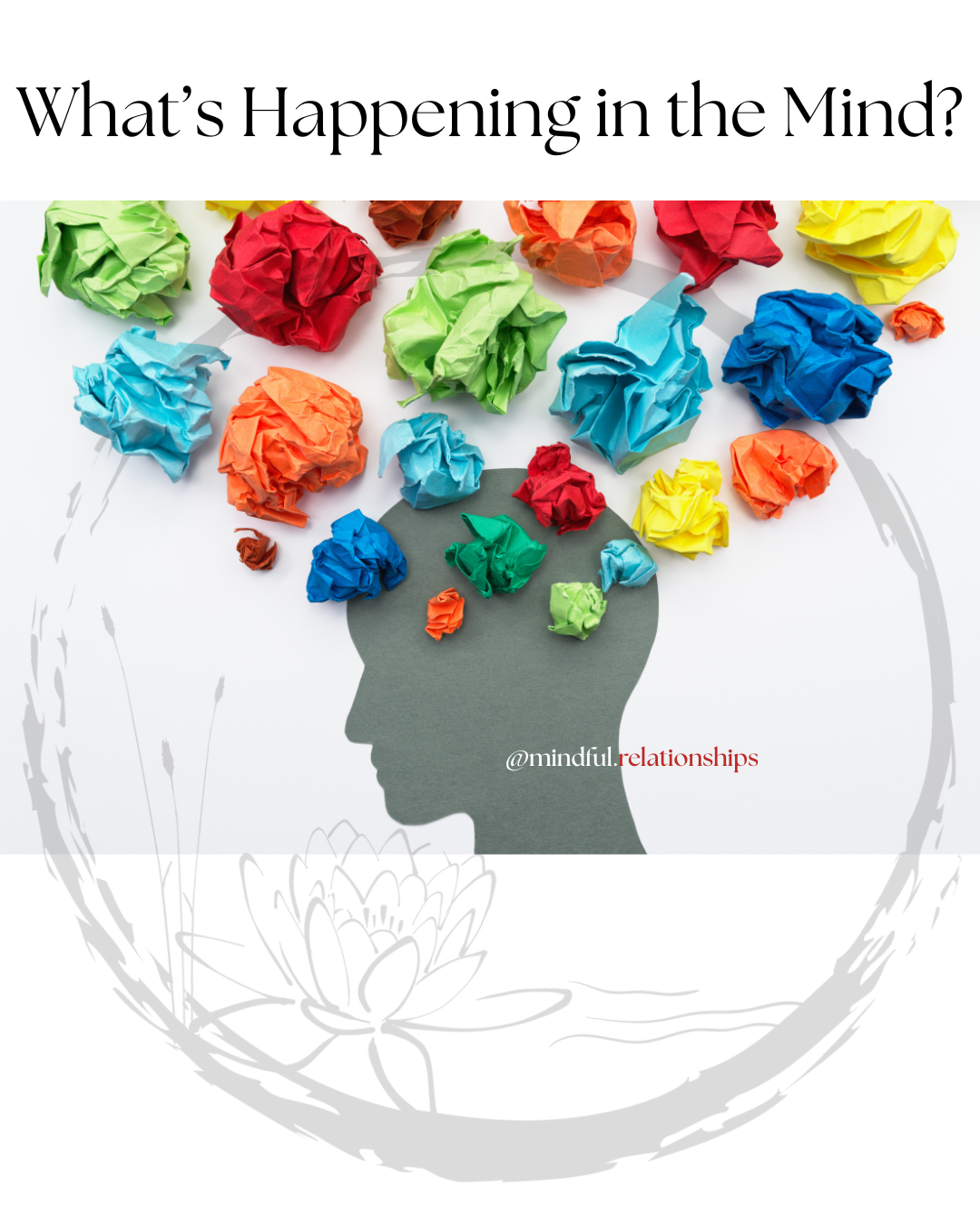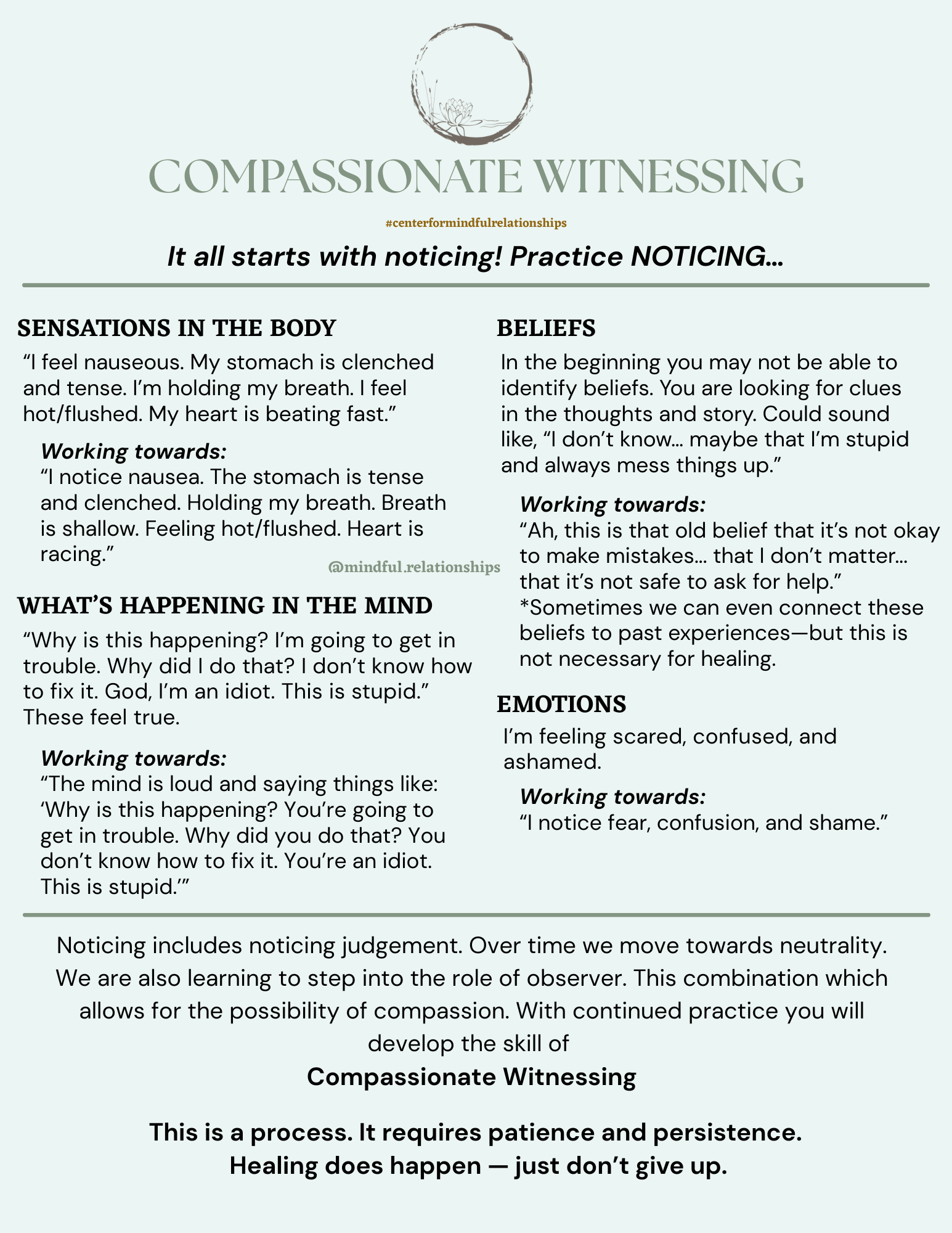Compassionate Witnessing: A Path to Love
In the fast pace of our modern world, it’s easy to get swept up in overwhelm and inner chaos. Our bodies tense, our minds spin, and our sense of groundedness disappears. In these moments, we often grasp for distractions and quick fixes that our culture models as normal, even necessary for survival. But distraction can also become a quiet form of self-abandonment, when our own needs go unseen by us.
Learning to pause, soften, and witness, gently and with compassion, what is here in this moment builds trust with ourselves. It is how we learn to attune and give ourselves what we truly need. This is intimacy.
This is the heart of Compassionate Witnessing; a practice rooted in Compassionate Based Awareness Therapy. It is a gentle and powerful method for slowing down, getting curious, and tuning into the nuances of your inner world; without judgment, without fixing, and without bypassing.
The answer never lies in the content. There is much suffering in content such as money, sex, food, body image, procrastination, work, school, laundry, (add your own). Freedom is never found in trying to solve the content and solving the content is never possible without understanding the process underneath the content. We can spend copious amounts of time focusing on what will never take care of us, in an attempt to care for us. Oh, the irony.
Instead, content reveals process. The content allows us to look below the content and with curiosity we seek to understand and to learn about this human. We see what needs to be seen: survival patterns, the automatic thoughts and beliefs systems, past hurts and/or traumas, and more. This allows for healing to unfold, and for parts of us that feel exiled or shamed to come into the light of our own presence. In this approach, answers will come.
And it all starts with noticing.
Step One: Notice Sensations in the Body
The body provides cues, not problems. These cues point to something needing care, needing attention, not distraction or correction.
Curiously ask:
What sensations am I noticing in my body?
Where are they located?
What words describe these sensations?
Do these sensations move around or stay still?
If I could give this sensation a color, what would it be?
Shift from, “I have no idea.” Or, “I am anxious and nauseous”
Compassionate Witnessing: “I notice fluttering in my chest, hard to breathe, tension in my belly and nausea. I see red and blue jagged vibrations.” This language softens the identification and opens a window of space between you and your experience.
Step Two: Notice What’s Happening in the Mind
The mind is a meaning making machine. It creates stories about what’s wrong, what might happen in the future, comparisons to the past, and what this says about you or others. In Compassionate Witnessing, we learn to name the mind’s activity without fusing with it. In Zen, we refer to this torturing voice as "ego."
Curiously ask:
What thoughts are running through my mind?
What conversation is happening in my head?
Is there a story being created or told?
Are there any assumptions?
What parts of this story feel true?
You’re not trying to suppress the thoughts; you are learning to observe them. This subtle yet profound shift is how we reclaim presence from the grip of conditioned ego narratives. Not everyone hears a conversation or distinct thoughts. If you pay close attention, over time, you will begin to sense that there is meaning making happening, but it may not be as obvious.
Shift from, “I’m so stupid. I can’t believe I did that. If they wouldn’t have yelled at me, I wouldn’t have reacted. It’s not my fault. This always happens to me.”
Compassionate Witnessing: “I can hear lots of thoughts blaming me, saying things like, ‘I’m stupid, it’s my fault and then it blames the others, but in the end, I get the blame.”
Step Three: Notice What Emotions are Present
Emotions are not problems to fix; they’re messengers. There is a human being who is having emotions that needs acknowledgment. Emotions arise where thought and sensation meet. Like a film, the storyline is carried by words, yet it is the music that moves us. Together, script and score create the scene. In the same way, when the mind’s story meets the body’s sensations, emotion comes alive. Instead of rejecting or dismissing the emotion, what if we met ourselves with care?
Curiously ask:
What emotions am I feeling? For assistance, reference the feelings wheel to the right…are there other words that resonate?
Are these emotions being created or intensified by the thoughts?
Can I sit with and notice what it is like to feel everything I’m feeling?
Can I acknowledge the emotion without believing the story?
Even if the story isn’t true, the emotion is real. The human needs witnessing. You deserve care, attention, and kindness and you need it from you.
Finding language for our emotions is sometimes difficult. Explore the variety of ways to describe what you are feeling. Check out this Feelings Wheel created by gifted artist Abby VanMuijen. She has an abundance of free resources on her website. I’m also including a list of feeling words you can explore.
Shift from,“I don’t know how I feel.” Or “I’m anxious and angry.”
Compassionate Witnessing: “There is shame, guilt, stressed, anxious, vulnerable, a desire to hide and anger. I can definitely feel sensations too. They are intense. It’s hard to separate them but I can a little.”
Step Four: Explore Underlying Beliefs
Thoughts are often rooted in old beliefs; assumptions formed early in life and reinforced through experience. These beliefs tend to operate in the background, unquestioned and often invisible.
Curiously ask:
What belief might be beneath this thought?
Is this belief something I assume to be true now?
Did I ever hear this as a child?
Sometimes, simply noticing a belief begins to loosen its hold. You may recognize it as a younger *part of you trying to protect or make sense of a painful experience.
*If you are not familiar with parts or subpersonalities, I’ll be writing more about that soon.
Shift from,“It’s not okay to let others know I’ve made a mistake and yet I always fuck up.”
Compassionate Witnessing: “There are beliefs that it’s not okay to make mistakes and yet I always do. It does feel true because I get in trouble all the time. I can remember as a kid getting in trouble all the time.”
Step Five: What would Compassion offer?
Given what you have seen with the above steps, what would compassion offer this human being? Is there an encouragement, a reassurance, a quote, or something else that comes to mind, something you might like to hear? This is often a VERY difficult space for most people, because we are not used to receiving compassion, especially from ourselves. This is not wrong. This is where you are, and where you are is okay.
This is why it is essential to disentangle thoughts, sensations, emotions, and beliefs from the human being. You are not your thoughts. You are not your sensations. You are not your emotions. You are not your beliefs.
Who you authentically are is goodness itself. You are the awareness that can see and the one who can choose to meet it all with compassion.
Shift from, “I don’t know. I’m sorry, try harder. You shouldn’t have gotten caught!”
Compassionate Witnessing: “It’s never been safe to make mistakes, so you learned to be afraid. This is really hard. It is okay to learn and you ARE learning.”
This step may feel impossible right now. THAT IS OKAY. Start where we are. If you keep practicing, compassion will eventually be available to you. How do I know this? Because you are here, reading this!
See below for a real-life example for what this can look and sound like….
Let’s walk through Compassionate Witnessing with a common scenario:
Issue: Jay missed a work deadline and lied when asked about it.
Sensations:
“I feel nauseous. My stomach is clenched and tense. I’m holding my breath. I feel hot and flushed. My heart is racing.”
→ Compassionate Witnessing: “There is nausea. A clenched stomach. My breath is shallow. My face feels hot. My heart is racing heart.”
Thoughts:
“I’m going to get in trouble. Why did I lie? I can’t fix this. I’m such an idiot. I’m exhausted.”
→ Compassionate Witnessing: “The mind is saying: ‘You’re going to get in trouble. You always mess things up. You’re an idiot and you’re tired. These thoughts feel true.”
Beliefs:
“I must be stupid. I always ruin things. I’m not good enough for anything.”
→ Compassionate Witnessing: “This feels like an old belief…that it’s not okay to make mistakes, that I’m not good enough, and that it’s not safe to be honest.”
Emotions:
“I’m scared, I’m ashamed and confused.”
→ Compassionate Witnessing: “There is fear. There is shame. There is confusion. These emotions are present, and I can witness them.”
What would compassion offer?
Prior there would not have likely been compassion. You would have either stayed in some version of shame or embarrassment and tried to do better or sick of the shame and blame would then go outward.
→ Compassionate Witnessing: “I see how hard you are working. I appreciate you. You get to learn. I’m so proud of you. You’re human. It’s okay to learn and I’m here with you.”
Why This Matters
When you slow down enough to witness your own experience with compassionate awareness, something shifts. You move out of reaction and into presence. You begin by being with yourself with the same kindness you would offer a struggling child or a dear friend.
This is not about technique; it is about presence. You are learning how to be with yourself. You are not a self-improvement project. Healing comes from the relationship you cultivate with yourself, not from the tools you use. Tools without presence lean toward “fixing” rather than attuning.
When we focus on being in relationship with ourselves, it stops being a tool we use on ourselves and becomes the way we are with ourselves. This is compassion. This is the practice to return to, again and again, because as human beings, with thoughts, sensations, and emotions, coming back to presence is a continual unfolding.
At the core, healing is not about doing more; it is about being with yourself more fully.
And that begins with noticing. Enjoy the practice of noticing.
I hope you also enjoy the flyers I have created. You can also find these social media links below.
Compassionate Witnessing
Use this handout to help you practice.
Compassionate Witnessing
Use this handout to help you practice!







